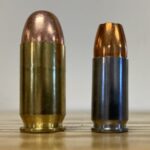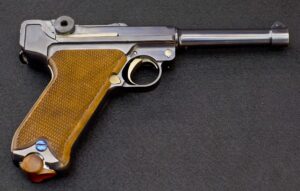
By Jim Dickson | Contributing Editor
The American dream of a .45 caliber Luger has been around for well over 100 years and it has been brought to final fruition by Lugerman, (AKA Eugene Golubstov).
A Russian born gun lover, Eugene came to the land of the Second Amendment to pursue his love of making fine firearms. Russians have had a love affair with the Luger pistol dating back to the days of the Czar and original Imperial Russian Lugers are extremely rare in this country largely because of the Russian’s determination to hang onto them.
The first .45-caliber Lugers were made for the 1907 U.S. Army Test Trials leading up to the adoption of the famed M1911 pistol so this was the gun Eugene wanted to make. The test trials leading up to the adoption of the M1911A1 were solely for the purpose of bringing the M1905 Colt up to the standards the Army demanded. No other gun was ever to be seriously considered for adoption and especially no foreign design.
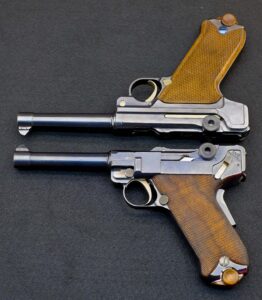
The Army was still stinging over the backlash it got from adopting the Norwegian designed Krag rifle and was determined not to ever go through that again. It didn’t help matters any when it was pointed out that, due to faulty manufacture, some of the American Krags were defective when none of the Norwegian-made Krags were.
The Savage .45 was chosen to give the Colt a run for its money but its excessive recoil precluded it from ever being seriously considered for adoption. John Browning would have all the help he needed from both Colt’s engineers and Army Ordnance engineers to perfect his design, the final version bearing only a superficial resemblance to the M1905.
Other designs were to be disposed of as quickly as possible. Ordnance’s ace in the hole was the fact that the .45 ACP ammunition specs had not yet been standardized and the ammunition used in the tests was notoriously unreliable. This led to Georg Luger demanding to have his gun tested with his own loads.
The Bergman, the White-Merrill, and the Knoble, were given the bum’s rush out the door. The Bergman went on to be a success in other countries. Revolvers were represented by Colt, Smith and Wesson, and the Webley automatic revolver but the revolver was what they were wanting to replace and its presence was mostly for comparison.
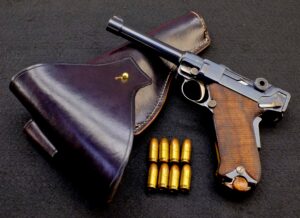
And that brings us around to the Luger, which did well in testing, coming in ahead of the Savage but Georg Luger became convinced that the Army was going to go with the Colt so he went back to Germany where his P08 Luger was adopted the next year.
Eugene got a copy of the blueprints taken from the original M1907 pistol. Since the .45 ACP was not standardized as a cartridge in 1907 the original test gun was not set up for the final version of the .45 ACP and Eugene had to adjust the gun for modern standard ammunition and achieved absolute reliability with it. Contrary to what many gun writers have claimed, the Luger is one of the 10 most reliable pistols ever made. For the record, the M1911 is the number one most reliable.
When the first Luger came out it was designed around the .30 Luger cartridge. After the German police found this round unable to quickly stop a rampaging giant German psychopath, Ludwig Lowe, the head of DWM ordered Georg Luger to chamber his pistol for the new 9MM cartridge that had been developed by blowing out the .30 Luger case to accept a 9MM bullet.
Luger protested that the gun needed to be scaled up in its operating components but Lowe rejected that extra expense and ordered him to make the existing gun work with that cartridge. This was done by adjusting the springs to the new recoil impulse. Proper springs are crucial to this design’s functioning and this was never a problem for any country using the Luger because their ordnance department took care of the springs and they only used standardized ammo.
Due to the Luger pistol’s extreme grip angle, the magazine has lots of drag so the spring is relatively inefficient. It therefore must be as strong as possible. It also is sensitive to overall cartridge length and rounds too long or too short won’t work right.
Most all Luger jams are the result of the Luger’s high speed toggle coming forward before the magazine can position a cartridge for feeding. If the springs are right the gun always fires. If not, it stubs the cartridge. Hot ammunition makes the toggle work faster increasing the chances for jams and a weak magazine spring is a guaranteed cause for jams.
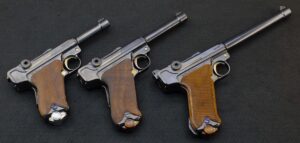
The Luger is well sealed against dirt, mud, and dust getting into the mechanism. It is actually more reliable than revolvers and even the M1911 when dropped in mud, which plagued the trench warfare of WW1. The Luger throws off the mud and keeps firing where revolvers and automatics with exposed hammers let mud in that ties up the works. The Luger will also work if the bore is plugged with mud. Firing will bulge the barrel but the gun will continue to function. Any gun whose barrel is surrounded by a slide like the M1911 is jammed solid with a bulged barrel until the barrel is replaced. The Luger proved to be the most reliable pistol used in WW1.
On top of this reliability is the Luger’s unrivaled ease of hitting. Just point your finger and the bullet from the Luger will connect. It has the greatest accuracy of any military pistol and it is not uncommon for a 9MM Luger to shoot a 10MM group at 25 yards.
Obviously something this good needs to be available in .45 ACP and that is what Eugene has accomplished. He hand-builds these guns to the original DWM standards. The grip angle is exactly the same as Georg Luger designed it to be for the .45 ACP round. It is a slightly different angle from what he designed for the .30 and 9MM Luger.
Eugene makes sure that every gun works with 100% reliability before he lets it leave his shop. He knows that any one of his guns may be called on to defend its owner’s life. While I know of at least two Grizzly bears killed with 9MM P08 Luger pistols, I prefer to use a .45 on anything that big. It is also more potent against criminal attackers.
Eugene first built the M1907 Test Trials Luger and then made some variations. The first was a Baby Luger with a 3.2-inch barrel and a shortened grip. Inspired by Georg Luger’s personal cut down carry pistol it makes a potent compact .45, and is an excellent gun to carry concealed.
Next came a 7-inch barrel target model with adjustable sights designed to take advantage of the Luger’s exceptional target accuracy. All three of these come with rust blue finish standard. I have carefully inspected and fired all three. Workmanship was the exact same as original DWM and as for accuracy I got a one-inch group at 50 yards out of the M1907 Luger and that gun had already been fired more than 10,000 rounds.
Eugene has also developed a P2020 version which omits the grip safety of the M1907 and has a WW2 type salt blued finish. Due to the larger space to work with he was able to employ a fixed ejector instead of the original M1907 spring loaded ejector. The bolt stop now has a wire spring instead of a flat spring.
These seemingly minor changes resulted in a rather drastic price reduction, though they are still pricey. For example, the original M1907 version with a glass top display case, holster, loading tool, and three magazines is $8,400. The Target version and the Baby version are $10,900 each while the P2020 is $4,000 for the pistol with two magazines and a loading tool. Contact Eugene for further pricing information.
You are getting handmade quality in one of the finest pistols ever.
Lugerman
1872 East Old Lincoln Highway
Langhorne, PA 19047
267-603-6116
Email: eugene@lugerman.com
Website: Lugerman.com

